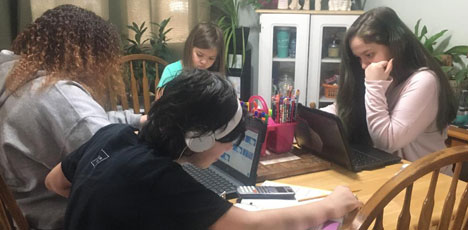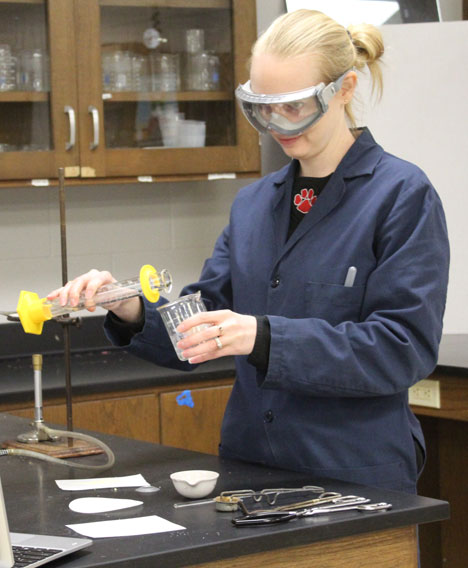
HOME SCHOOLING — From left: Amy Shaw, Corbin Delacruz, Emily Delacruz and Tatianna Delacruz work on a school project from home.
By DEB BENTLY
Contributing Writer
As with any complex, large-scale endeavor, there are differences in perspective. But there seem to be two statements NRHEG teachers can agree with unconditionally:
“I miss seeing the kids,” and, “This is a lot of work.”
As they finish the second week of the Distance Learning plan required of all Minnesota schools, teachers have encountered circumstances which range from delightful surprise to heartrending disappointment—much like any other day at school. But the surprises and disappointments have changed.
Of the roughly 75 teachers employed by NRHEG, 50 responded to a survey asking for their impressions and experiences. When asked to rate the program overall, 40 indicated they felt things were going well, and another six provided a neutral rating. When asked to evaluate how much work the program requires, all but two rated distance learning as requiring more work, with 34 saying it calls for “quite a bit more” effort to operate online instruction.
“I thought my life revolved around school before,” commented one teacher. “But now I start my day between 6 and 7 a.m. making sure everything is online and ready to go, and I’m often still communicating with students up until 7 p.m.”
One gigantic learning curve for teachers as they switch from in-school to online instruction has been learning to operate the necessary technological equipment and the various delivery systems. During the days when school was not in session, teachers collaborated intensively to share their various skills and approaches, so that everyone would have at least sufficient knowledge to begin online teaching.
“In the beginning, it was a lot more work,” observes third-grade teacher Todd Beynon. “I had to establish new routines for myself and begin approaching things from a new direction. I’m still always looking for ways to keep kids engaged. When you find it, though, it can be really good. The students are truly excited to use that technology and show what they can do.

ON-LINE TEACHING — NRHEG teacher Mrs. Amanda Inouye tapes an experiment to post on-line.
“I fully believe you get the best from the students when you can see them in person every day,” Beynon comments, “but online learning has been better than I expected.” Beynon mentions that parents have been “patient” about start-up glitches. “I had always been a little curious what online teaching would be like,” he says. “I hadn’t realized how important it would become to coordinate and communicate with families. Every day the picture changes and shifts just a little bit, and we have to stay on top of it.”
Secondary Family and Consumer Sciences (FCS) teacher Kelly Delacruz has also faced considerable challenges finding ways to deliver her widely varied curriculum. “I was going to teach them to sew,” she says regarding the seventh-grade students who had just arrived in her classes for their third-trimester rotation. “Now I have to look for new ways to approach fabrics, textiles, and their roles in our lives.” One creative solution was to expand her usual curriculum surrounding fabric care, and require students to show evidence they are doing at least one week’s worth of their families’ laundry. She is also adding broader coverage of “social/emotional learning,” which is an important aspect of family and interpersonal relationships.
“Of course ‘family and consumer sciences’ are what our students are now learning more about every day,” Delacruz observes. “I keep working to make students more mindful of the learning they are experiencing every day at home.”
“It really hurts me not to be able to interact with the kids every day,” says fifth-grade teacher Marcus Fischer. “So I do what I can for them. My focus is to help them feel like there are some things in their lives that are consistent. Give them something that, even though it’s not exactly what they had before, is a routine they can adapt to.”
Fischer also acknowledges that online teaching is time-consuming. “At least I’m getting quicker than I used to be,” he says jokingly, “but it does take quite a bit longer to prepare—I would say at least another hour per day.”
Like many teachers, Fischer admits that overcoming self-consciousness is something of a difficulty. “At first, I would stop recordings and do them over. I would think, ‘The kids are going to make fun of that,’ and erase it. But now, I think to myself, ‘We’re all human,’ and I let it ride.”
Fischer says he has been delighted with the way his students have adapted to online learning. “They’re showing leadership and responsibility,” he comments. “They want to make people proud of them, so they’re right there at 8:30, ready to go.”
Secondary science teacher Amanda Inouye feels she has certain advantages when it comes to online teaching because she took a fair number of master’s-level college courses using the format. “I remember the different ways my college professors set up their lessons, and I try not to repeat what I saw as mistakes,” she says.
Like most teachers, Inouye is using a combination of live on-line meetings with students and pre-recorded lessons and demonstrations which students can access at a time of their choosing. Also like most, she feels online teaching is going reasonably well. “It’s not as good as having students with us every day,” she says, “but it’s the best we can do.”
Inouye perhaps speaks for most teachers when she observes that some students are flourishing under this new format, while others are floundering. For those willing to take personal responsibility for their progress and who can traverse the winding paths of technology, things are going well. For those who experience roadblocks—perhaps difficulty in adapting, finding uninterrupted time to concentrate on their work, complications with technology—things may be going downhill.
Elementary reading interventionist Jessica Williams has taken on the role of helping some students experiencing problems of those types. During a typical in-school day, Williams meets with learners who need help bringing their skills up to grade level. Her tasks have been adjusted to providing one-on-one support in a variety of subjects and, with luck, reducing the stress some floundering students may feel.
Like three other teachers interviewed for this article, Williams is also experiencing the students’ perspective, since she has children at home working on their online classes. “Teachers have been available and flexible,” she observes. “Without the distractions of commuting to school and interacting with others, in some ways it’s easier for my kids to get their homework finished.” But Williams has spoken with others whose experiences seem less positive.
“What I hope parents know is that they shouldn’t become overly stressed by these circumstances,” she says. “Looking at the bigger picture, these few weeks—however long they continue—are just a short piece of their children’s educational journey. We recognize that people are doing their best in the face of complicated, unprecedented difficulties. We teachers are in the same boat.
“Our ultimate goal is to work together to make the best of a bad situation, and keep on doing it until the bad situation ends.”
